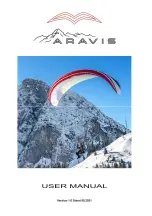
12
All lines and risers should be carefully untangled and arranged in a way that they do not
catch on anything. It is equally important to untangle the brake lines so that they are clear
and cannot catch on anything during launch. The brake lines should run freely through the
low friction rings to the trailing edge of the canopy.
Make sure the risers are not twisted; this can prevent the brake lines from running freely
through their rings. It is often impossible to untangle lines during flight.
It is important that no lines are looped around the canopy. Also called a “line-over”, this
may have disastrous consequences during take-off.
Finally connect the risers with your harness by using the main karabiners. Check carefully
that they are closed properly.
Launching
Your Aravis will launch with either the forward or reverse technique. The wing should be
laid out in a pronounced arc, with the centre of the wing higher than the tips.
Forward Launch - Nil wind
When gently holding the A-risers move forward positively, your lines should become tight
within one or two steps and the Aravis will immediately start to inflate. You should maintain
a constant pressure on the risers until the wing is overhead. It is important to guide the A-
risers smoothly upwards in an arc, keeping your elbows bent and hands at the level of the
shoulders. Do not pull down or push the risers forward excessively, or the leading edge will
deform and possibly collapse making taking-off more difficult and potentially dangerous.
Once the wing comes overhead, it may require a brake input from stopping it overflying
you. Once the Aravis is inflated correctly, accelerate smoothly off the launch.
Reverse Launch - Light to Strong Winds
This method of launch makes it easier for the pilot to control the rising of the canopy and is
therefore recommended. The reverse launch technique is generally recommended for the
Aravis. Take the brakes and turn around to face the wing. Pass one set of risers over your
head as you turn. Make sure the lines are free from knots or tangles. Check that the
airspace and visibility are clear. Gently pull up the glider in an arc with the A-risers. When
the glider is overhead, brake it gently if necessary, turn around and launch. In stronger
winds, be prepared to take a few steps towards the glider whilst braking as it inflates. This
will take some of the energy out of the glider and it will be less likely to overfly you or
inadvertently pull you off the ground. The reverse-launch technique can be used in
surprisingly light winds too.
Warning! Make sure that the steering lines are not wrapped around the main lines during
the reverse launch. In this case, any faster pull on steering line can damage the sheath on
the main lines.
Содержание ARAVIS 17
Страница 1: ...1 ...
Страница 31: ...31 LINE PLAN ARAVIS ...
Страница 34: ...34 CHECKS Name Company Date Signature Stamp ...
Страница 36: ...36 ...













































